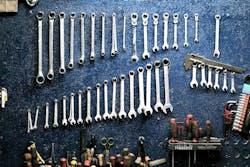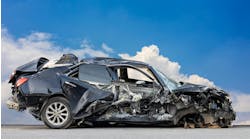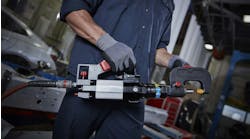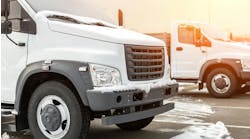It was 4:50 p.m.—just 10 minutes to close—when the phone rang.
Steve Kielow picked up.
“DeGrazia’s Auto Body; Steve speaking. How may I help you?”
It was a customer, one he knew quite well, in fact. Her family had brought their cars to the shop Kielow managed in Seattle, Wash., for years.
But, more notably, she was in distress.
She told Kielow how she had an issue with her car and stopped into a local dealership. The dealership said it could take a look at the car, then diagnose it and then charge for what it would take to fix the car. The hourly rate at the dealership was $150, so, she was looking at spending, at minimum, $300 for just one hour of work.
Please, she asked, could she bring in her car to the shop?
The answer was a no-brainer to Kielow.
“I think every job I do is a standout moment,” he says. “I’m helping someone put their life together again in a small fashion.”
Kielow and his technician were able to diagnose the issue in five minutes and get the rear gate open in another five minutes.
“We called and found a part, actually sent someone to go pick it up,” he says.
From start to finish, the shop fixed her car in 45 minutes.
“In the end, that hug, smile and handshake they gave me was worth the extra work,” he says. “It stuck out to me because she was so grateful we were able to get her on her way and to a very important meeting the next morning.”
That customer was just one of many that Kielow and his team have helped over the years. Stories about customers gratitude are an everyday occurrence in his shop, which he has managed for 14 years. He follows a simple procedure, but an effective one nonetheless: Treat others how you would want to be treated. Not only is it a motto to live by, but it’s also the motto that has helped build the $2.3 million business.
Combining Background Knowledge
Early in his career, Kielow realized he could make a career out of working for his father in his body shop. Yet, Kielow realized he would never make a name for himself if he didn’t branch out in the industry.
So, he decided to go into the insurance industry first.
He spent years traveling 100 miles or more away from his family’s body shop and meeting new shop operators and owners in the industry. Most of that time was spent working in downtown Seattle, roughly 30 miles north from where he grew up.
About 14 years ago, he started working for his family business again.
He’s used that knowledge since returning to the collision repair industry, namely in how has helped change some of DeGrazia’s processes. He took what he saw on the road as an insurance adjuster and applied it at his current workplace.
For one, Kielow helped the owner expand the shop into 5,600 square feet. He also helped increase the shop’s annual revenue from about $1.8 million to roughly $2.3 million. One aspect of that growth came from relationships that Kielow formed with local dealerships. The shop partners with several dealerships in the area, including Ford, Chevy and Toyota franchise. Kielow will often visit a dealership in person to help write an estimate. In return for helping the dealerships, the dealers direct more collision repair work to DeGrazia’s.
Kielow’s insurance background also comes in handy when greeting customers for the first time. After working in insurance, he had a better understanding of what questions to ask the customer and how to calm them down.
Kielow says he’ll invest anywhere from five minutes to two hours with a customer, depending on the situation. He’ll sit the customer down and lay out the situation, saying, “OK, here’s where you’re at, and here’s what happened.” Then, he’ll show them how to set up an accident report.
He makes sure to ask questions like, “How are you doing?” And, Kielow focuses his queries on anything that will give him a better sense of where the customer’s head is at, and whether he can gauge if there is something he can do to calm them down.
Kielow’s Tips to Relationship Building
Steve Kielow, manager for Degrazia’s Auto Body, shares quick tips to building a loyal customer base.
“Whether I’m helping a new customer or working with a repeat customer, I treat them all the same,” Kielow says.
Here are his quick tips to building business relationships with customers:
-
Treat everyone the same respect. Use titles like Ma’am, Sir, Misses and Mister unless otherwise told.
-
Look them in the eye during conversations. Eye contact is very important to let the other party know that you’re hearing what they are saying.
-
Let them know what needs to be done. Tell customers the work that needs to be done, even if it is not what they want to hear.
-
Outline the options. If the customers are paying themselves, offer other options to do the repair so that the pocket book is not hit too hard.
-
Ignore the time of day. A customer that walks in toward the end of the day is the same as the customer that walked in at the beginning of the day. Customers walk in before the shop officially opens and at close and they all receive the same service.
Presenting a Family Business
Kielow and his boss, owner Tom DeGrazia, are only a month apart in age. And, between the two of them, they have roughly 80 years of experience in the industry.
Kielow grew up in a family-operated collision repair shop and, to this day, he believes a family business can offer more to the customer than a large corporate one.
One way Kielow shows his employees that he cares about them is by allowing anyone that needs to come in later in the morning to simply work later at night. That flexible scheduling benefits morale in the workplace. And, because of it, Degrazia’s is also able to offer extended hours to provide service to customers that may need it.
“I want to be friends with people, but at the same time there is one person I do answer to and that’s the owner,” Kielow says. “I try to lay down the law but not do it too much, because I do believe a friendlier atmosphere makes for a better workforce.”
Kielow will occasionally provide lunches for his team and has birthday parties for everyone in the shop. During the week, he checks in with each staff member to see how they’re doing and make a point to ask if there’s anything with which they need help.
“With a bigger shop, it’s harder to connect one on one with your team,” Kielow says.
And, Kielow operates his body shop with only three DRPs. He says he doesn’t want to be working with a lot of DRPs so he can be less beholden to insurers when it comes to how long the repair needs to be done.
Offering an Extra Service
Kielow is the last team member in the shop at night and is usually the second one in the shop in the morning following behind his painter.
He says he likes to be in the office for a longer period of time because he is able to be on hand in case any customers come in with an emergency.
Kielow not only offers extended repair hours to customers, he also adds a personal touch to each repair job. After the vehicle is delivered to the customer, Kielow sends a personal thank you note that he writes himself. He’ll thank them for the service and also inquire into whether there is anything the body shop can further do for them.
Often, customers come in and show him an estimate they received at another shop that has a lower price. When that happens, Kielow takes the time to do an estimate of the damaged car and compare his estimate to the one the customer brought in. If the client’s estimate is basically a match to Kielow’s, he’ll price-match his estimate.
Sometimes, he’ll have to lay both estimates down for the customer to see and take the extra time to explain what the other body shop puts on its estimate versus what he found, and why there might be differences.
“We do the price-matching for other body shops but it never impacts the outcome of the repair or refinish,” he says. “We offer a lifetime warranty and pride ourselves on the workmanship of our final product.”
More Service, Less Money
Steve Kielow, manager for Degrazia’s Auto Body, has determined key steps to offering a price-matching service to customers.
Step 1: Check the P-pages when writing the estimate.
Step 2: Look at the car as if it were yours. Write it as if it were your car, whether it is being paid through insurance or customer pay.
Step 3: Explain in detail what you wrote and why wrote it to the customer. Do this step while the customer is looking at the car along with you.
Step 4: If the customer needs a repair that is a small job that won’t take too long or be too expensive, do not charge and send them on their way.
SHOP STATS: Degrazia's Auto Body Location: Seattle, Wash. Average Monthly Car Count: 80-100 Staff Size: 8( 1 owner, 1 receptionist, 3 body techs, 1 painter, 1 owner's son, 1 manager) Shop Size: 5,600 square feet; Annual Revenue;$2.3 million




